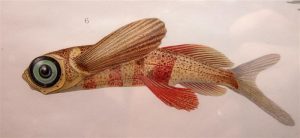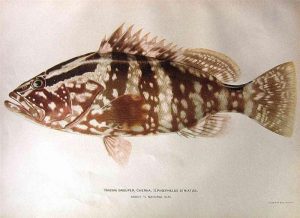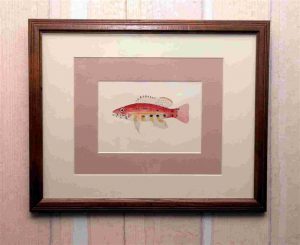Aquarium hobbyists often have other interests related to their primary hobby. SCUBA diving, sport fishing and boating are all other common hobbies for aquarists. Another related hobby is collecting fish art, specifically antique fish prints. These offshoots of early scientific exploration show a richness of colors and shapes that rival many outright artistic works. Ranging from the fanciful interpretations of the aquatic world as seen by early naturalists, to the exquisitely rendered accurate depictions made by early 20th century marine biologists, there is a huge variety of fish prints available at a wide variety of prices. It is only natural for people to incorporate related activities such as art collecting into their primary hobby (in this case aquariums). This humanizes the hobby and adds breadth and depth to the experience (Hemdal 2006).
This article is intended to give some basic information to aquarists who may decide to delve into the side-hobby of collecting antique art prints of fish. Properly conserved, (mounted and framed to keep the prints from deteriorating) fish prints can be a great addition to any room with an aquarium theme (Hemdal 1987).
Try not to be an “art snob”. Do not collect antique fish prints based solely on the rarity of the piece, or who the artist was. Unless you are buying and selling these prints on speculation, or as an investment, the art will be hanging on your walls – so choose prints that you find aesthetically pleasing and which match your décor. It may be that reprints will serve your artistic needs at a better price than the actual antiques will. The old phrase, “I may not know art, but I know what I like” should be the guiding force for new collectors.

An 1893 woodcut print of a pair of snipefish from a German book.
Types of prints
Woodcut prints – These early rustic-looking prints lack much of the fine detail seen in later lithographs. This printing technique requires that a relief of the image to be printed first be carved into a wood block. Ink is applied and then the block is pressed onto paper, creating the print.
Hand-colored engraving – For increased detail, artists learned to use metal to etch the image of their subject in metal rather than wood. Still, the resulting image was monochromatic, so the artist would then hand-apply colors to each finished print. Typically, these are the rarest to find, and are usually the most valuable. Due to their individual production methods, they are most often seen in smaller formats and in older prints. Because the artists applied colors to the prints by hand, there is more variability in their quality as is seen in later, mechanized print production methods.

A hand-colored Shaw and Nodder engraving of a squirrelfish from the mid-1800’s.
Color Lithographs – Typically make the most attractive type of framed artwork. Later prints can be very detailed and extremely accurate in their portrayal of animal life. Lithography is the process in which the artist first draws the image on a series of separate plates, and then full color prints are made from those plates.
Offset Lithography – This is the modern technique used to make most prints nowdays. It is a photo-mechanical technique in which the image to be printed is first transferred to plates and then printed onto the paper.
Modern Reproductions – A relatively inexpensive way to collect aquatic artwork, many people feel that since they are not “real”, that their use as art is some how lessened. However, for very rare, early works, these may be the only material of such subject matter available at a reasonable price.

Detail from a montage of early 20th century fish on a scientific plate produced by the Monaco Museum.
Print condition
As with any antique, the condition of an item has a considerable affect on its value, and prints are no exception. Foxing is an aging process that results in the formation of small spots or stains on a print. The presence of some foxing does not detract too much, and may help to ascertain that the print is genuinely old. Age toning usually causes the colors of a print to wash, and the paper develops an overall yellow or brownish cast. Creases and folds can be serious problems with old paper items, prints often degrade and split along such damaged areas. Untrimmed edges (where a print was removed from a book) are not an issue, and this is generally preferred over somebody trying to trim those edges. The matting process can hide a number of defects in a print, so always try to inspect the unframed print.

Offset lithograph of a Nassau Grouper from Jordan and Evermann’s 1902 edition of American Food and Game Fishes.
Subject matter
The subject of the print has some bearing on the print’s “collectability”. A Denton fish print of a salmon is going to be more popular than one of a carp because there are many anglers interested in buying fish prints of game fish. This popularity increases the demand, (and therefore the value) of these prints. Aquarists are more often interested in non-game species, so the demand may not be as high for those subjects.
Means to acquire prints
Most fish prints are obtained through dealers, either from retail antique stores, specialty bookstores or at auctions. Rarely, prints can be found as illustrations inside old books (see sidebar – “the death of a book”). In most instances, buying prints (perhaps already professionally framed) from a knowledgeable retail dealer is the best way to insure that you are purchasing authentic prints that are of good quality. Retail
purchases do tend to cost more, but for new collectors, or those only desiring a print or two, this route is usually the best. Auctions can be a
very cost-effective means to acquire prints, but they do require that the bidder research the prints thoroughly so that an estimated value can be determined. Auctions are typically run with the best interests of the seller in mind. Some auction items will have a reserve bid, or a high
starting bid. This insures that the seller will receive a minimum predetermined price for their item. If the reserve is set too high, you will not have a chance to get a truly good deal. Be certain that you understand all of the details of the auction, for example is there a seller’s premium? This is a percentage of the auction price that is added in to the final sale price. If an auction has a 20% buyer’s premium, and you win an item with a bid of $100, your final price will be $120. You should also be aware if sales taxes will be assessed on the final price.

A reproduction of a very early woodcut print. Unfortunately, this was sold as an original antique by an unscrupulous dealer in England to an unsuspecting customer.
In some live auctions, the first item of a series will not realize its full price. It seems that many bidders will just watch this first item, and then begin bidding in earnest on subsequent ones. Some bargains can be obtained by remaining alert for these deals. Beware of a live auction in which there are a number of collectors all vying for a certain type of item, as this tends to drive the prices up through bidder competition. The best scenario would be to attend a no reserve, no premium, live auction that is focused on say, furniture, in which there are a few fish prints consigned. Most of the bidders will be attending to buy the furniture, and you may end up winning the prints for a very low price.
Online auctions are of course very popular. They do have some very specific differences from live auctions, the most important one being the inability for the prospective bidder to view the item in person. This is an extremely important issue as the condition of an antique print has so much impact on the item’s value. There are unfortunately a few online auctions in which the seller attempts to deceive the bidders. Digital photographs can be modified to show the auction item in better light; reducing damage, enhancing colors, etc. Although outright fraud does occur (where reproductions are sold as true antiques) it is more common for the seller just to be vague about an item’s true age. Read the fine print closely for such buzzwords as “in the style of” “attributed to” and “suggestive of”. These “weasel words” can be attributed either to the artist, or to the supposed age of the item. In other cases, an auction for an “antique fish print” will have the term “reproduction” buried in the fine print, at the bottom of the auction page, and is likely missed by many of the bidders. Finally, bidding fraud is rampant in some auctions; see the sidebar entitled “Shill Bidding”.
One strategy that may work if you are unsure as to the honesty of a seller is to never bid more for the item than you would be willing to pay for an equivalent high-quality reproduction. Many online bidders find it safest to identify a few good sellers in the category they are interested in, and then focus their efforts on buying prints that seller for the majority of their purchases.
Buying fish prints through online auctions can be exciting and fun, but some additional advice should be considered. First, always read the entire item description and never bid if you are not able to pay. Secondly, as much fun as it can be to jump in early and bid on an item, it is always best to wait until the final minutes of the auction and then bid the price you are willing to pay. Bidding early will only serve to drive the final price higher, and will tip off competing bidders as to your intentions. If you bid on an item, with perhaps four days to go, other bidders can then research your past bidding habits (through your feedback scores) and may learn things like how high you will bid on certain items, etc. Third, watch for items put up for sale in which the seller has misspelled a phrase in the title. This is more common than you might think – people tend to search for auction items using keywords. A seller who enters an auction title of “Antigue Fish Print” will not have as active of an auction as somebody who spells it correctly.
Shill Bidding
The term “shill bidding” refers to the shady practice that some auctioneers use of having an accomplice in the bidding group bid against real bidders in order to drive the price of an item up. Illegal in many places, it is difficult to track effectively either in live or online auctions. Art and antiques are particularly susceptible to this practice. If you are bidding on a new camera, it is a very objective process. If you have done your research, you already know what the camera is worth and will not bid more than its actual value. Art and antiques are much more subjective. If a certain piece catches your eye, you are more apt to raise your bid in response to a shill bid since you have a more emotional attachment to the item. Auctioneers will tell you, “Only bid what you truly want to pay for an item in order to avoid shill bidders”. This is specious reasoning; your maximum price may still be more than you could have acquired the item for had the shill bidder not bid it up! For online auctions, always view the seller’s current and past auctions to look for multiple appearances of another user’s name. Shill bidding sometimes does not work out, and the shill bidder ends up being listed as the “winner”.
Names of Some Well-Known Ichthyologists Associated with Fish
Prints
(In many cases, the actual work was performed by other people for this person)
- Bleeker (circa 1870) Produced the famous Atlas Ichthyologique
- Bloch (1723-1799) Well-known early natural history texts
- Bonnaterre (1752-1804) Early natural history texts
- Couch (circa 1860) Illustrated Fishes of the British Isles
- Cuvier (1769-1832) German natural history writer
- Denton (circa 1900) Fishes of the United States
- Haeckel (1834-1919) Very detailed taxonomic prints
- Lacépède (1756-1825) European taxonomist

Even a small chromolithograph can be matted and framed well enough to hang on a wall.
The Death of a Book
It is unfortunate, but most antique fish prints on the market today were removed from classical biology texts. Natural history volumes are cut up by unscrupulous investors who then sell the individual prints for many times the original value of the book. The text, cover and spine and usually discarded, wasting much valuable information. While this deplorable practice is difficult to condone, it does allow prints to become available to a wider audience. In a few rare instances, unbound prints are found. Although these are always much more expensive, they should always be given preference over prints cut out of books. In a few cases, books are found moldering unused on a shelf somewhere with their covers broken and pages falling out. While it might be possible for a bindery to repair these severely damaged books, it may well be that the prints from such a book could be put to better use as art prints. One such book was purchased for $35 and produced $450 worth of fish prints at auction.
References
- Dance, S.P. and Swinney, G.N. 1990. Classic Natural History Prints – Fish. Arch Cape Press, New York, New York.
- Hemdal, J.F. 2006. Advanced Marine Aquarium Techniques. TFH publications, neptune City, New Jersey
- Hemdal, J.F. 1987. Decorating around the aquarium. Freshwater and Marine Aquarium Magazine 10(11):68.
- Simard, F. et-al 1998. Les Poissons – Illustrations Scientifiques Dessins Naturalistes & Fantaisies. Musée Océanographique, Monaco



0 Comments